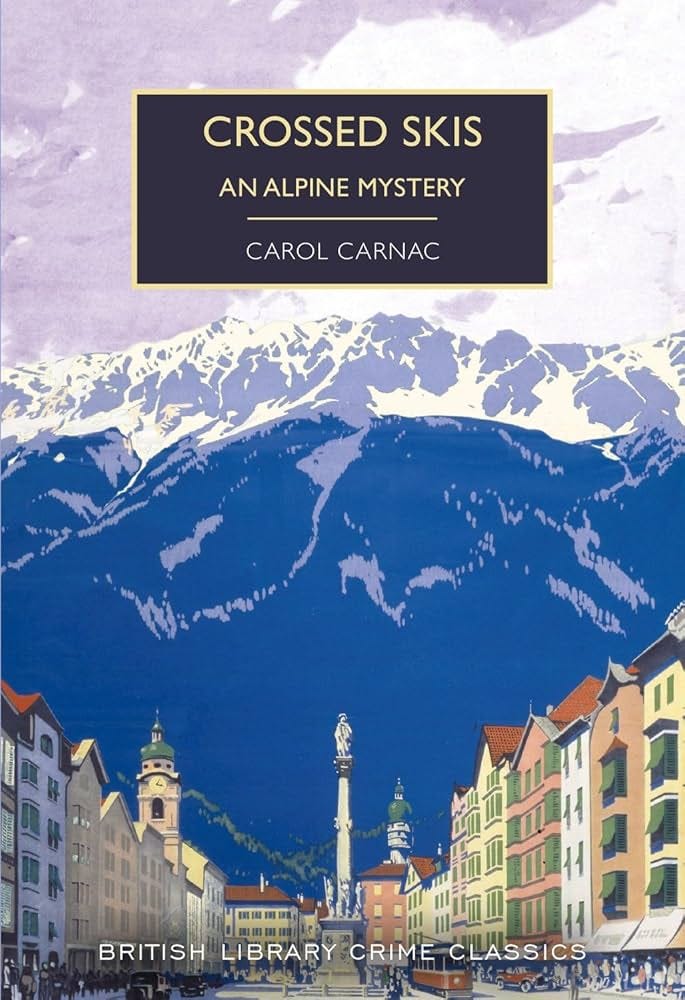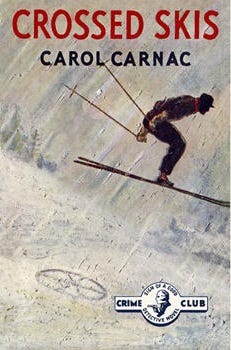I have a deep admiration for the disciplined writer/bloggers out there, the ones who approach their subjects with a rigor I don’t possess. The writers who work their way methodically through a genre, reading all of one author’s work before moving on to the next, or reading a book for each year of their decade of interest. The list makers.
I’m too much of a magpie to stick with this approach, flitting from author to author and title to title as it suits me. I made a list when I started this Substack of the books I planned to cover and the order in which I wanted to cover them. I think I made it through the first three before I diverged; the list is now a reminder that no matter how well I plan, I lack the essential follow-through.
Because of this, there are huge gaps in my Golden Age knowledge, areas I’m always meaning to get to until some shiny new (old) book comes along to tempt me. Last week, in honor of a ski trip I took with my family, I wrote an overview of a handful of Golden Age-era (ish) books set at ski resorts.
I had only read a few on the list, but I had so much fun making it that I decided to turn the topic into a little series. (To be clear, I love to make lists. As soon as they’re finished, I generally set them aside and forget all about them. And while I’m terrible at lists, I love a theme. And yes, I did abandon a book mid-read to embark on this little project. I’m nothing if not consistent in my inconsistency.) This winter feels never ending, so I should have plenty of time to dig into the books on my list.
I’m starting off with Crossed Skis by Carol Carnac, one of the pen names of Edith Caroline Rivett (the other, better known one is E. C. R. Lorac).1 The story begins with the chaotic departure from London of a skiing party of sixteen (eight men, eight women; some are friends, some strangers) for Lech am Arlberg, a ski town in Austria. Carnac, a skier who dedicated the novel to the fifteen friends she had taken a similar trip with the year before the book was published, captures the excitement and anticipation of their train and boat journey out of England, with its gray skies and slushy rain. Equally evocative are her descriptions of a depressed post-war London, where bombed out buildings stand in ruins among the living and rationing is still in effect (the book was published in 1952).
Alternating chapters with the exuberant skiers are chapters following Chief Inspector Julian Rivers and his junior, Inspector Brook. They are investigating the death of a man found in the remains of a fire at a rooming house in Bloomsbury. The imprint of a ski pole in the mud outside, along with the accretion of clues, leads them to eventually link the murder (for it is murder, naturally) with the ski group. The man they are after, wanted for the murder of a porter during a robbery, is a skier, and they have reason to believe he has left the country under cover of the ski party.
Their investigation provides a stark counterpoint to the ski sections, filled with picturesque details of the farms surrounding the village, the hotels and the local landscape. The two storylines run on parallel tracks (ha) until they converge in Austria. Rivers and Brook, both skiers, practically will the investigation to take them out of England to the sunny slopes, and the novel reaches its climax when they arrive just ahead of a storm that finds them hunting their killer across a mountain trail in the blizzard.
Carnac handles the large crowd of skiers by essentially dropping about half of them once they arrive in Austria, where they are barely mentioned and rarely heard from. Instead, she focuses on a smaller group within the group, led by Kate and Frank, the oldest members of the trip. Bunked together in a chalet are Tim and Robert, an Irishman new to the group (there is a lot of very weird-to-me bias against the Irish, taking the form of “ribbing” in the story). Robert, along with Neville, another newcomer, are the best skiers in the group, so much of the action centers around their good-natured competitiveness on the slopes. Things take a turn, however, when the pounds Robert had converted to Austrian money go missing from his room. Upon investigating, he and his friends find ten British pounds in its place, which Neville has lost from his room. Robert’s hot Irish temper (yikes) as well as his status as a stranger to the rest of the group make him look suspicious in the eyes of the others.
For the reader, the circumstantial evidence piles up against O’Hara with such rapidity that the only thing you can be certain of is that he’s not the killer. If you’re paying close attention to the story and are able to keep track of who’s who (I admit that I gave up trying to remember the relationships between characters, along with who was a stranger and who was the friend of a friend, pretty early on), sussing out the killer should be pretty straightforward.
By the time the police arrive to hunt him down, armed with a few clues the reader hasn’t been privy to, Kate and Frank have already begun to suspect one of their group of not being what he seems. Once the police have the case wrapped up, Kate helpfully details all of the clues the attentive reader could have picked up along the way, a well-laid trail of breadcrumbs leading inevitably to one man.
It’s a fairly unusual structure for a Golden Age-style mystery, and I admit that while I enjoyed the atmosphere of the London-set scenes, I preferred the chapters exploring the various dynamics within the ski group and the ways they played off each other. I was as eager as Rivers and Brook were to get them out of London to Lech. Once there, their interactions with the group were shorter than I would have liked, with a good chunk of it taking place after the case has been wrapped up, when Rivers tells Kate and Frank about the London investigation. But the Austrian ski resort setting, as well as the squalid Bloomsbury rooming house, were a refreshing departure from the usual country house setting and Carnac deftly managed her two story lines until their inevitable convergence. If you’re stuck in your own slushy winter world, Crossed Skis is a fun escape to brighter, sunnier pastures.
Hat tip to Adam Thomas of Murder at the Manse for the recommendation.








I'm glad you enjoyed it! Thanks for the mention. I'd forgotten the fact that Carnac was a skier who dedicated it to her skiing friends. It's always fun to see the real-life background to books like this.